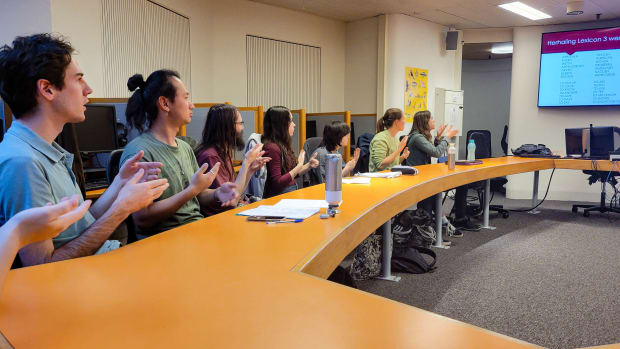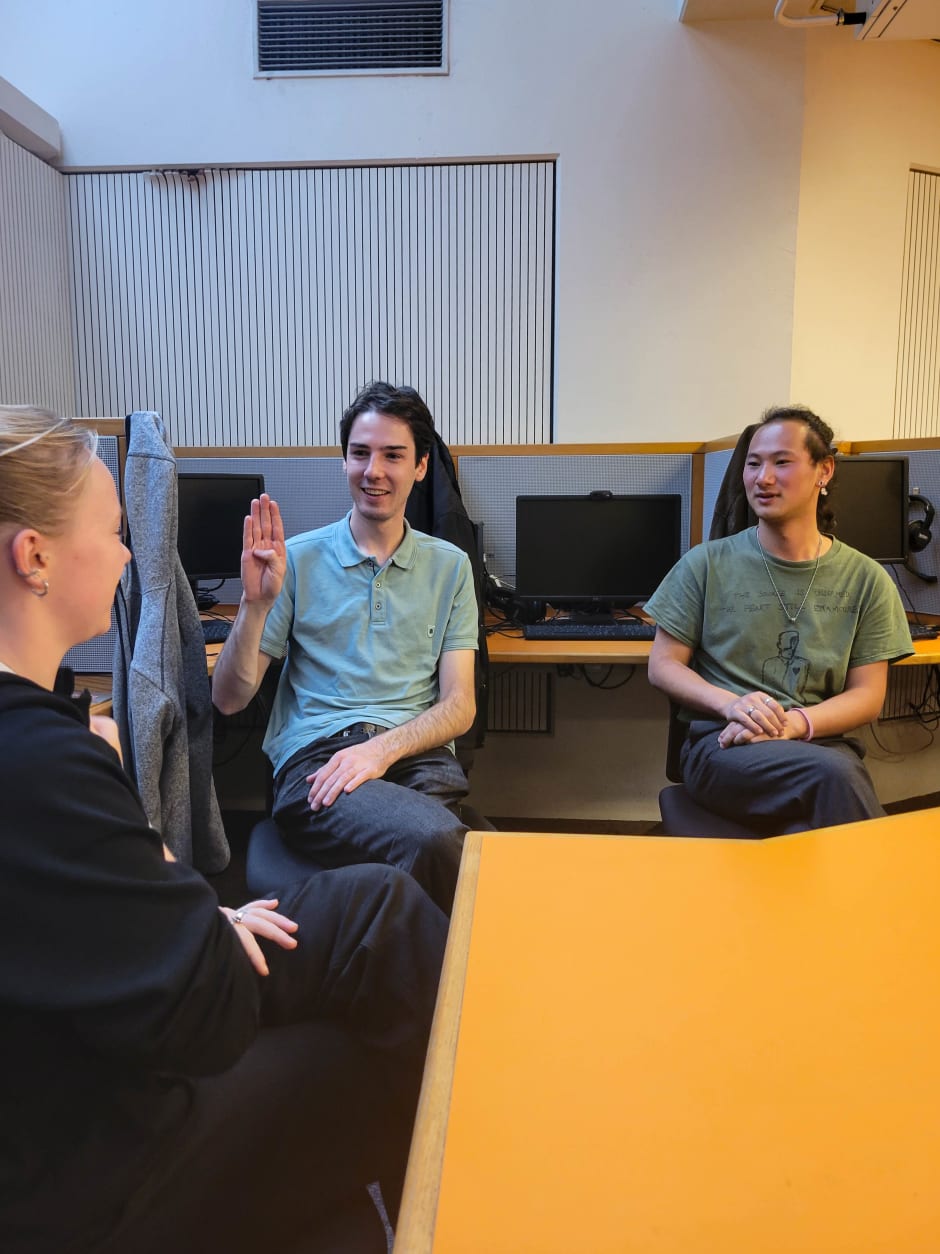
Joining a class of the sign language bachelor: “During class we do not use our voices"
Always wondered what the official hand gesture for Almere looks like? In the lead-up to International Week of the Deaf, Folia spent a day with the only bachelor’s degree in sign language in the Netherlands: “It takes a lot of concentration and energy, but above all it’s great fun.”
It might surprise you, but even Sint-Michielsgestel, a small village near Den Bosch, is represented in the lexicon of dutch sign language. A group of students is watching intently as their teacher starts performing the sign by making a little cross motion, and then bursts out laughing. “Sint-Michielsgestel, what is that even?” one of them whispers to her neighbour. Not long after, the classroom is dead silent again. We are guests in a class of Language Proficiency Sign Language of the Netherlands 1, and in this class there is no speaking.
The lecture series in which students learn the first 800 signs of Dutch Sign Language serves as the introduction to a six-part series of courses, spread over two years, and is part of the only bachelor’s programme in Sign Language of the Netherlands, at the UvA. With International Week of the Deaf just around the corner (coming week, for those who hadn’t marked it), this is the perfect moment to take a look at the programme.
Ten minutes before the workshop starts, I walk into the classroom. The first students are drifting in too, quietly taking their places around the long, orange, U-shaped table in the middle. Just as I’m about to introduce myself, I notice on the whiteboard the rule that the sixteen students are clearly already used to: “during class we do not use our voices.” So I search silently for a seat at the back of the room, on the ground floor of the P.C. Hoofthuis.
A silly sign
When I am seated, curiosity wins over obedience, so I whisper to the twenty-year-old Carmen Eckhardt, asking why she chose this unusual programme. “I want to work with children later, also children who cannot speak, so it seemed sensible to me to learn a base of sign language,” she explains.
She likes the course so far, although she and her peers are thrown in at the deep end: “That you’re not allowed to speak in class was very strange the first time, but you get used to it. In the end you learn very many new signs quickly in this way; I believe we’ve already had 300.” Her favourite so far? She taps with her index and middle finger against her thumb: “That means ‘strange’. Fun, because it’s just such a silly sign.”
Then the lesson begins, and teacher Marijke Scheffener seems to signal that we are going to start with a kind of game. One by one the students point to one another, then make a sentence of four or five signs toward each other. And honestly, I don’t have a clue what I’m looking at. Only when, about ten minutes in, they practise a model sentence, and evidently someone asks for a cup of coffee, and the teacher laughs as she hands her mug to the student who made the request, can I for the first time guess what was just said.

Almere
One student clearly enjoys it, signing with gusto, while another hesitates a little, but in all cases: most of it passes me by. One moment someone taps their chest, the next hands swing past their body or fingers press against the cheek. Without any prior knowledge I don’t get far. Until suddenly an example sentence appears on the board: “I am going to read a book.” And yes, indeed, that imaginary book in the hands of Scheffener is quite a clear sign once you know what to look for.
Next the students split into groups of four, time to practise themselves. The conversations they have resemble introductions, it turns out when someone asks Scheffener for her help. What is the sign for “Almere,” is the question. It turns out to be a diagonal movement of the hand downwards – that must represent the “A” – followed by a little wave – for “meer”.
Concentration and energy
In the corner of the room the 24-year-old Shen van Bezooijen is busy taking notes. With pen and paper, no less. In this class there’s no trace of the dreaded desks full of laptops, often as much used for chatting via WhatsApp web as for note-taking. During this highly interactive ninety minutes, not joining in is really not an option. “It’s a tiring subject because you constantly must participate,” van Bezooijen explains. “It takes a lot of concentration and energy, but most of all it’s really fun.”
The seed was planted when he was nine, when the student met a deaf boy at scouts. “Together with his mother he told us about being deaf, and taught us a few signs. I’ve always kept that in the back of my mind. I’m also studying educational sciences, and feel that hard-of-hearing children lag behind somewhat in education. I hope that in this way I can contribute to more inclusive education.”
Soon the colours are up. One by one we go around the class, pointing out the different shades of people’s clothes. Blue trousers here, a grey sweater there. Things go well, until Scheffener notices the reporter in the corner has chosen to wear this morning a multicoloured woollen jumper. The teacher makes a mock-desperate hand to her head and begins listing off colours as half a rainbow makes its appearance, but then has a change of heart. She turns to the board, and takes the moment to teach the students the sign for “many,” which is much more efficient.
Webcam
During the final part of the lesson the students practise individually on the computers in the room. The assignment is to think up a short sentence and record it on their webcam. When afterwards all the videos are shown to the full class on the big screen, the students can barely hide their embarrassment, and there are awkward giggles. Not surprising, of course: they have only been at it for a few weeks and clearly still need time to get used to the norms of the subject. But the willingness to practise is obvious. The temptation to chat is sometimes strong, and now and then something is whispered, but most of the time even the giggly little side-conversations mainly happen in sign language.
Toward the end of the lesson the teacher comes over to me. “Have you followed at all?”, she asks. Hardly. “Difficult, isn’t it?”, she says, smiling as she walks back. This code language doesn’t crack in an afternoon.

